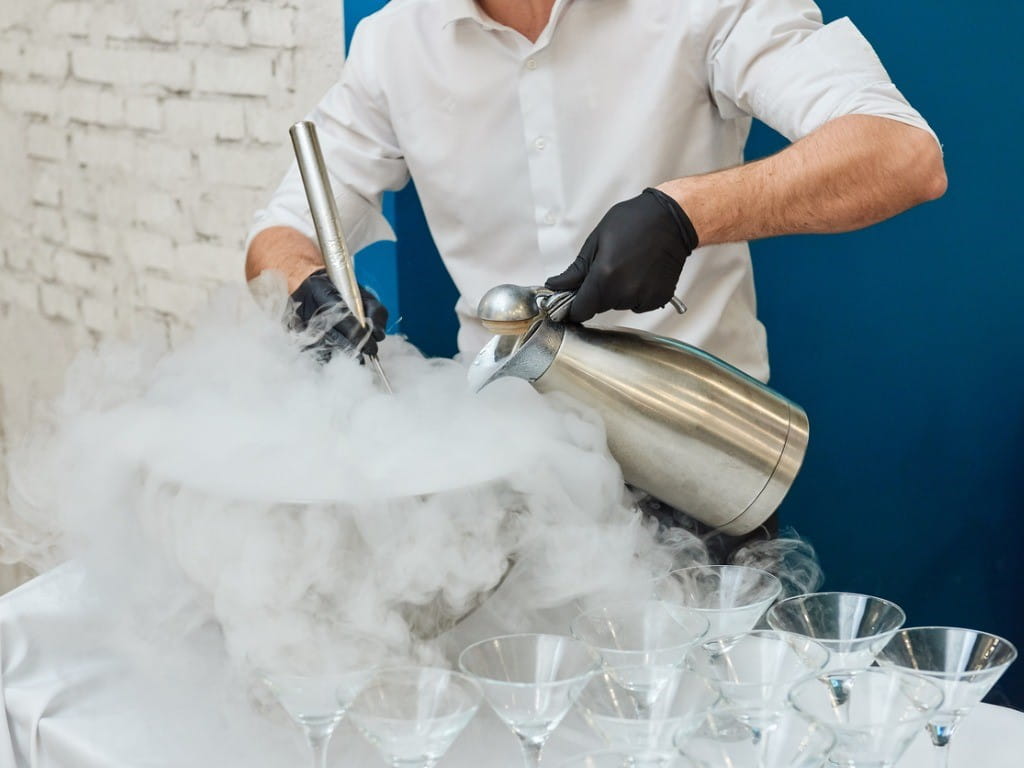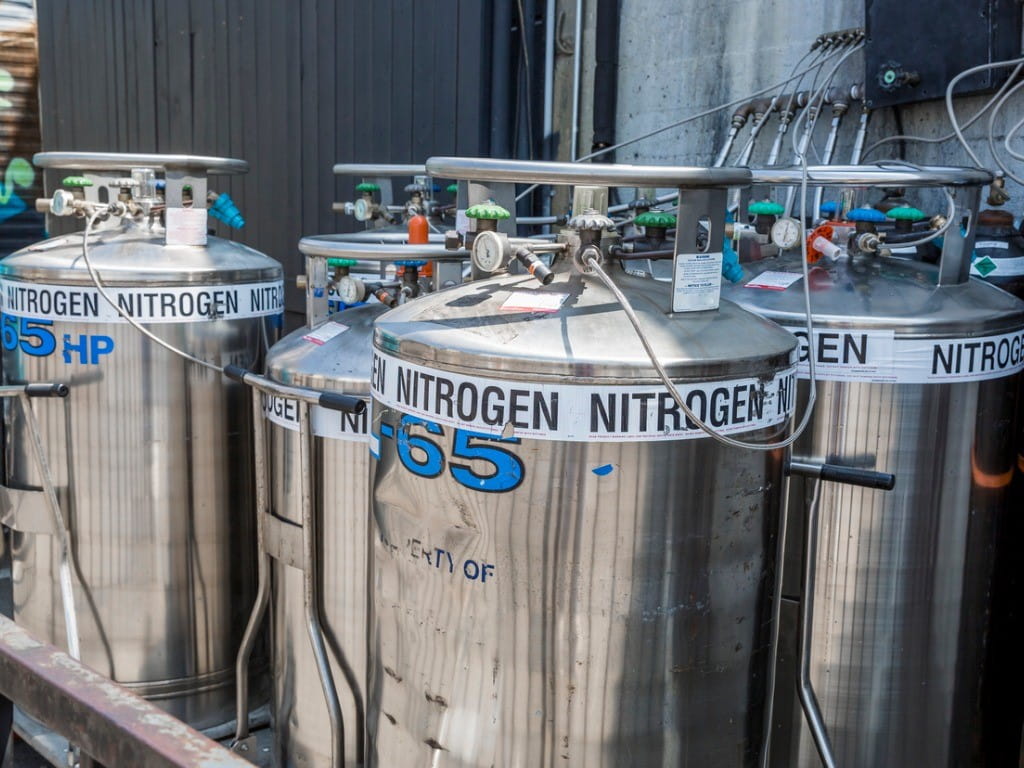Liquid Nitrogen Can Cause Severe Burns

The Bottom Line
Nitrogen is the most abundant gas in the air we breathe. Liquid nitrogen is extremely cold and is used in medical, scientific, industrial, commercial, and even culinary settings where extreme cold is required. Although liquid nitrogen is generally inert if untouched, it has the potential to cause severe injury and even death if handled improperly.

The Full Story
Nitrogen is the most abundant component of the air in the air we breathe (79%). Liquid nitrogen (LN) is an odorless, colorless, tasteless, non-corrosive, non-flammable, and extremely cold substance that is commercially produced by cryogenic (cryo- means extremely cold) distillation. During this process, the individual components of atmospheric air (mainly oxygen and nitrogen) are cooled until they liquefy and are then able to be separated. For nitrogen, this occurs at about -320° F!
LN's ability to keep things well below the freezing point of water has made it useful in many fields including medical, scientific, industrial, commercial, and even culinary. Some common uses include cryotherapy to remove warts and skin cancers, cryopreservation of genetic samples like sperm and eggs, food product transport and storage, and cooling for superconductors. A unique use of LN is as a method of freezing novelty food and drinks instantaneously.
LN is considered nontoxic and inert (unless you come into contact with it!). If mishandled or misused, it can cause serious consequences or even death.
- Skin contact. Skin contact with LN can result in burns, blistering, and severe frostbite injury, which can occur within seconds of exposure. Skin damage from exposure to LN may be extensive enough to require surgery or amputation. Personal protective equipment such as safety goggles, face shields, insulated gloves (loosely fitting), and lab coats or aprons can reduce the risk of skin injury.
- Ingestion.
- LN has been used to instantly freeze drinks and food and to produce a spooky vapor effect. When applied to food that is served in a manner that ensures complete evaporation of LN as well as a normal food temperature, it is generally considered a safe and fun way to enjoy these unique creations. However, LN added to food or drink at the point of sale and immediately before ingestion has resulted in cases of serious injury. According to the FDA, products such as "Dragon's Breath," "Heaven's Breath," and "Nitro Puff" that are often sold in malls, food courts, and kiosks are prepared by adding LN to food or drink immediately before it's to be consumed. Unless allowed to completely evaporate, the LN can remain so cold that it could causes burns or frostbite injuries. Even if the LN fully evaporates, these injuries may still occur due to the exceptionally cold food temperatures that can result from contact with LN.
- Another dangerous effect with ingestion of LN is due to its large expansion ratio (1 to 694). The expansion ratio is the volume of a certain amount of a substance in liquid form compared to the volume of the same amount in gas form at room temperature. This means that a tablespoonful of LN can quickly become more than 2½ gallons of gas. If swallowed, the rapid expansion of evaporating LN in the stomach can result in major stomach injuries such as perforations and ruptures.
- Inhalation.
- Inhaling cold vapors released by LN can trigger breathing problems, especially among people with baseline respiratory illnesses like asthma. This includes vapors coming from LN-treated food or drink.
- Even more concerning is that LN is an asphyxiant, meaning it displaces oxygen in the air. If inhalation occurs, especially in an enclosed space without proper ventilation, oxygen concentrations can become dangerously low and lead to dizziness, unconsciousness, and even death.
Handling LN requires extreme precaution and safety measures including proper storage and protective equipment. Those working with LN should be very familiar with its properties and aware of all safety considerations. Additionally, the FDA advises consumers to avoid eating, drinking, or handling food products prepared with LN at the point of sale. Edible products that have been treated with LN prior to point of sale and are no longer are extremely cold present a lower risk of injury.
If you've had direct contact with liquid nitrogen and your skin is cold or discolored, move to a warm place and soak the affected area in warm water. Follow up with emergency medical evaluation as soon as possible. In the event of inhalation where someone is suffering from a lack of oxygen, protect yourself and then move them to fresh air immediately and seek urgent medical attention.
If you think someone has been exposed to or might be having an adverse effect from liquid nitrogen, get help with the webPOISONCONTROL® online tool or call 1-800-222-1222 for guidance.
Kristina Yee, PharmD
Certified Specialist in Poison Information
Poisoned?
Call 1-800-222-1222 or
Prevention Tips
- Store and use liquid nitrogen containers in areas with adequate ventilation (never in a confined space).
- Never allow liquid nitrogen to make contact with any part of your body. Always wear appropriate personal protective equipment when working with liquid nitrogen including safety goggles, face shields, insulated gloves (loosely fitting), and lab coats or aprons.
- Avoid consuming edible products that have been treated with liquid nitrogen at point of sale (e.g., Dragon's Breath, Heaven's Breath, and liquid nitrogen-infused beverages).
This Really Happened
Case 1. An emergency physician called Poison Control seeking advice regarding a 2-year-old boy who was brought to the ER shortly after having swallowed some ice cream that was made using LN. According to his parents, the boy took a few bites of the ice cream and within 5 minutes started clutching his chest, gasping, and stopped talking. His symptoms lasted about an hour. In the ER, the boy looked well and the symptoms that had been previously reported had all resolved. Poison Control explained the potential concerns for frostbite injury and advised observation and a food challenge to ensure that the boy could swallow without difficulty. He tolerated food and was sent home. A follow-up call the next day found that the boy was back to his normal self.
Case 2. A 34-year-old man was admitted to a hospital 45 minutes after stepping in a shallow container of LN while wearing only socks. His lower leg and foot were completely frozen. Due to tissue swelling, he required dermatofasciotomy (slicing open tissue to relieve internal pressure) of parts of his foot. He developed progressive tissue destruction and loss of circulation and requested amputation of the lower leg rather than chronic therapy. His recovery from the amputation was successful (from Mückley et al., 2007).
Case 3. A 13-year-old boy swallowed a snack that had been cooled with LN. He immediately had severe abdominal pain and shortness of breath. At an ER, his abdomen was swollen and hard. Laparotomy (surgical opening of the abdomen) found a large amount of gas under tension and multiple areas of erythema (red tissue from inflammation). A 4-cm perforation was found in his stomach. After surgery, he recovered with no complications and was discharged after 8 days in the hospital (from Kim, 2018).
For More Information
References
Pollard JS, Simpson JE, Bukhari MI. A lethal cocktail: gastric perforation following liquid nitrogen ingestion. BMJ Case Rep. 2013 Jan 7;2013:bcr2012007769. doi: 10.1136/bcr-2012-007769.
Poisoned?
Call 1-800-222-1222 or
Prevention Tips
- Store and use liquid nitrogen containers in areas with adequate ventilation (never in a confined space).
- Never allow liquid nitrogen to make contact with any part of your body. Always wear appropriate personal protective equipment when working with liquid nitrogen including safety goggles, face shields, insulated gloves (loosely fitting), and lab coats or aprons.
- Avoid consuming edible products that have been treated with liquid nitrogen at point of sale (e.g., Dragon's Breath, Heaven's Breath, and liquid nitrogen-infused beverages).
This Really Happened
Case 1. An emergency physician called Poison Control seeking advice regarding a 2-year-old boy who was brought to the ER shortly after having swallowed some ice cream that was made using LN. According to his parents, the boy took a few bites of the ice cream and within 5 minutes started clutching his chest, gasping, and stopped talking. His symptoms lasted about an hour. In the ER, the boy looked well and the symptoms that had been previously reported had all resolved. Poison Control explained the potential concerns for frostbite injury and advised observation and a food challenge to ensure that the boy could swallow without difficulty. He tolerated food and was sent home. A follow-up call the next day found that the boy was back to his normal self.
Case 2. A 34-year-old man was admitted to a hospital 45 minutes after stepping in a shallow container of LN while wearing only socks. His lower leg and foot were completely frozen. Due to tissue swelling, he required dermatofasciotomy (slicing open tissue to relieve internal pressure) of parts of his foot. He developed progressive tissue destruction and loss of circulation and requested amputation of the lower leg rather than chronic therapy. His recovery from the amputation was successful (from Mückley et al., 2007).
Case 3. A 13-year-old boy swallowed a snack that had been cooled with LN. He immediately had severe abdominal pain and shortness of breath. At an ER, his abdomen was swollen and hard. Laparotomy (surgical opening of the abdomen) found a large amount of gas under tension and multiple areas of erythema (red tissue from inflammation). A 4-cm perforation was found in his stomach. After surgery, he recovered with no complications and was discharged after 8 days in the hospital (from Kim, 2018).
